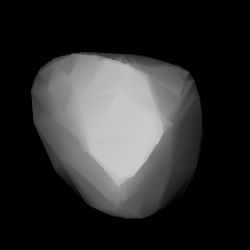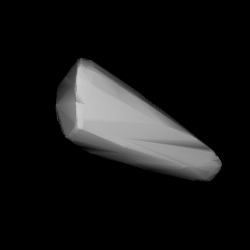Related Research Articles

Stephania is a dark background asteroid from the inner regions of the asteroid belt, approximately 32 km (20 mi) in diameter. It was discovered on 19 May 1881, by Austrian astronomer Johann Palisa at the Vienna Observatory. The C-type asteroid has a rotation period of 18.2 hours. It was named after Princess Stéphanie of Belgium.

1578 Kirkwood, provisional designation 1951 AT, is a Hilda asteroid from the outermost regions of the asteroid belt, approximately 52 kilometers in diameter. It was discovered on 10 January 1951, by astronomers of the Indiana Asteroid Program at Goethe Link Observatory in Indiana, United States. The asteroid was named after American astronomer Daniel Kirkwood.

1746 Brouwer is a Hilda asteroid from the outermost region of the asteroid belt, approximately 64 kilometers in diameter. It was discovered on 14 September 1963, by IU's Indiana Asteroid Program at Goethe Link Observatory near Brooklyn, Indiana, United States. It was named after astronomer Dirk Brouwer.
1062 Ljuba, provisional designation 1925 TD, is a carbonaceous background asteroid from the outer regions of the asteroid belt, approximately 58 kilometers in diameter. The asteroid was discovered on 11 October 1925, by Soviet–Russian astronomer Sergey Belyavsky at the Simeiz Observatory on the Crimean peninsula. It was named after female paratrooper Ljuba Berlin, who died at an early age. The C-type asteroid has a longer-than average rotation period of 33.8 hours.

1165 Imprinetta, provisional designation 1930 HM, is a carbonaceous Meliboean asteroid from the outer regions of the asteroid belt, approximately 49 kilometers (30 mi) in diameter. It was discovered on 24 April 1930 by Dutch astronomer Hendrik van Gent at the Union Observatory in Johannesburg, South Africa. The asteroid was named after Imprinetta Gent, wife of the discoverer.
2067 Aksnes, provisional designation 1936 DD, is a rare-type Hildian asteroid from the outermost region of the asteroid belt, approximately 44 kilometers in diameter. The asteroid was discovered on 23 February 1936, by Finnish astronomer Yrjö Väisälä at Turku Observatory in Southwest Finland. It was named after astronomer Kaare Aksnes.
2038 Bistro, provisional designation 1973 WF, is a stony asteroid from the inner regions of the asteroid belt, approximately 12 kilometers in diameter. The asteroid was discovered on 24 November 1973, by Swiss astronomer Paul Wild at the Zimmerwald Observatory near Bern, Switzerland. It was named for the Bistro restaurant.
9298 Geake, provisional designation 1985 JM, is a Mitidika asteroid from the central regions of the asteroid belt, approximately 12 kilometers in diameter. It was discovered on 15 May 1985, by American astronomer Edward Bowell at Lowell Observatory's Anderson Mesa Station near Flagstaff, Arizona, United States. The asteroid was named for British astronomer John E. Geake.
1460 Haltia, provisional designation 1937 WC, is a stony background asteroid from the central regions of the asteroid belt, approximately 8 kilometers in diameter. It was discovered on 24 November 1937, by Finnish astronomer Yrjö Väisälä at the Iso-Heikkilä Observatory in Turku, Finland. The asteroid was named after Halti (Haltia), Finland's highest peak on the border to Norway.
1409 Isko, provisional designation 1937 AK, is a carbonaceous background asteroid from the central regions of the asteroid belt, approximately 35 kilometers in diameter. It was discovered on 8 January 1937, by astronomer Karl Reinmuth at the Heidelberg-Königstuhl State Observatory in southwest Germany. The asteroid was named after Ise Koch, wife of astronomer Fritz Kubach.
1303 Luthera, provisional designation 1928 FP, is a dark asteroid and the parent body of the Luthera family, located in the outermost regions of the asteroid belt. It measures approximately 90 kilometers in diameter. The asteroid was discovered on 16 March 1928, by astronomer Friedrich Schwassmann at the Bergedorf Observatory in Hamburg, Germany, and later named after German astronomer Robert Luther.
1877 Marsden, provisional designation 1971 FC, is a carbonaceous Hildian asteroid from the outermost region of the asteroid belt, approximately 35 kilometers in diameter. It was discovered during the Palomar–Leiden Trojan survey in 1971, and named after British astronomer Brian Marsden.

1256 Normannia is a dark Hilda asteroid and slow rotator from the outermost regions of the asteroid belt, approximately 69 kilometers in diameter. It was discovered on 8 August 1932, by astronomer Karl Reinmuth at the Heidelberg-Königstuhl State Observatory in Germany. The asteroid was likely named after the Normans who gave their name to the region of Normandy in France.
1646 Rosseland, provisional designation 1939 BG, is a stony asteroid from the inner regions of the asteroid belt, approximately 12 kilometers in diameter. It was discovered on 19 January 1939, by Finnish astronomer Yrjö Väisälä at Turku Observatory in Southwest Finland. It was later named after Norwegian astrophysicist Svein Rosseland.
2959 Scholl, provisional designation 1983 RE2, is a carbonaceous Hildian asteroid from the outer regions of the asteroid belt, approximately 34 kilometers in diameter. It was discovered on 4 September 1983 by English–American astronomer Edward Bowell of the Lowell Observatory at Anderson Mesa Station near Flagstaff, Arizona. The asteroid was named after German astronomer Hans Scholl.

1902 Shaposhnikov is a dark Hilda asteroid from the outermost region of the asteroid belt, approximately 92 kilometers in diameter. It was discovered on 18 April 1972, by Russian astronomer Tamara Smirnova at the Crimean Astrophysical Observatory in Nauchnyj, on the Crimean peninsula. The asteroid was named after Soviet astronomer and WWII casualty Vladimir Shaposhnikov. It was one of the last larger asteroids discovered in the main belt.
1258 Sicilia, provisional designation 1932 PG, is a dark background asteroid from the outer regions of the asteroid belt, approximately 44 kilometers in diameter. It was discovered on 8 August 1932, by astronomer Karl Reinmuth at the Heidelberg-Königstuhl State Observatory in southwest Germany. The asteroid was named after the Italian island of Sicily.
1585 Union, provisional designation 1947 RG, is a dark background asteroid from the outer regions of the asteroid belt, approximately 52 kilometers in diameter. It was discovered on 7 September 1947, by South African astronomer Ernest Johnson at the Union Observatory in Johannesburg, South Africa. The asteroid was named after the discovering observatory.

4230 van den Bergh (prov. designation: 1973 ST1) is a highly elongated Hildian asteroid and member of the Schubart family from the outer regions of the asteroid belt. It was discovered on 19 September 1973, by Dutch astronomer couple Ingrid and Cornelis van Houten at Leiden Observatory, on photographic plates taken by Dutch–American astronomer Tom Gehrels at the Palomar Observatory, California. The assumed carbonaceous C-type asteroid has a very long rotation period of 88 hours and measures approximately 37 kilometers (23 miles) in diameter. It was named for Dutch–Canadian astronomer Sidney Van den Bergh.
5176 Yoichi, provisional designation 1989 AU, is a background asteroid from the central regions of the asteroid belt, approximately 17 kilometers in diameter. It was discovered on 4 January 1989, by Japanese astronomers Seiji Ueda and Hiroshi Kaneda at the Kushiro Observatory on Hokkaido, Japan. The likely elongated asteroid has a brightness variation of 0.45 magnitude, and occulted a star in the constellation Cetus in November 2014. It was named for the Japanese town of Yoichi.
References
- 1 2 3 4 5 6 7 8 9 "JPL Small-Body Database Browser: 1911 Schubart (1973 UD)" (2017-07-04 last obs.). Jet Propulsion Laboratory . Retrieved 3 December 2017.
- 1 2 3 Schmadel, Lutz D. (2007). "(1911) Schubart". Dictionary of Minor Planet Names. Springer Berlin Heidelberg. p. 153. doi:10.1007/978-3-540-29925-7_1912. ISBN 978-3-540-00238-3.
- 1 2 "Asteroid 1911 Schubart". Small Bodies Data Ferret. Retrieved 21 October 2019.
- 1 2 3 4 Nugent, C. R.; Mainzer, A.; Masiero, J.; Bauer, J.; Cutri, R. M.; Grav, T.; et al. (December 2015). "NEOWISE Reactivation Mission Year One: Preliminary Asteroid Diameters and Albedos". The Astrophysical Journal. 814 (2): 13. arXiv: 1509.02522 . Bibcode:2015ApJ...814..117N. doi:10.1088/0004-637X/814/2/117. S2CID 9341381 . Retrieved 3 December 2017.
- 1 2 3 4 5 6 Grav, T.; Mainzer, A. K.; Bauer, J.; Masiero, J.; Spahr, T.; McMillan, R. S.; et al. (January 2012). "WISE/NEOWISE Observations of the Hilda Population: Preliminary Results". The Astrophysical Journal. 744 (2): 15. arXiv: 1110.0283 . Bibcode:2012ApJ...744..197G. doi:10.1088/0004-637X/744/2/197. S2CID 44000310 . Retrieved 3 December 2017.
- 1 2 3 4 Tedesco, E. F.; Noah, P. V.; Noah, M.; Price, S. D. (October 2004). "IRAS Minor Planet Survey V6.0". NASA Planetary Data System – IRAS-A-FPA-3-RDR-IMPS-V6.0. Bibcode:2004PDSS...12.....T . Retrieved 17 October 2019.
- 1 2 3 4 5 6 "LCDB Data for (1911) Schubart". Asteroid Lightcurve Database (LCDB). Retrieved 3 December 2017.
- 1 2 3 4 Usui, Fumihiko; Kuroda, Daisuke; Müller, Thomas G.; Hasegawa, Sunao; Ishiguro, Masateru; Ootsubo, Takafumi; et al. (October 2011). "Asteroid Catalog Using Akari: AKARI/IRC Mid-Infrared Asteroid Survey". Publications of the Astronomical Society of Japan. 63 (5): 1117–1138. Bibcode:2011PASJ...63.1117U. doi: 10.1093/pasj/63.5.1117 . (online, AcuA catalog p. 153)
- 1 2 Warell, Johan (October 2017). "Lightcurve Observations of Nine Main-belt Asteroids". The Minor Planet Bulletin. 44 (4): 304–305. Bibcode:2017MPBu...44..304W. ISSN 1052-8091 . Retrieved 3 December 2017.
- 1 2 Stephens, Robert D. (October 2016). "Asteroids Observed from CS3: 2016 April - June". The Minor Planet Bulletin. 43 (4): 336–339. Bibcode:2016MPBu...43..336S. ISSN 1052-8091. PMC 7243975 . PMID 32455386.
- ↑ Dahlgren, M.; Lahulla, J. F.; Lagerkvist, C.-I.; Lagerros, J.; Mottola, S.; Erikson, A.; et al. (June 1998). "A Study of Hilda Asteroids. V. Lightcurves of 47 Hilda Asteroids". Icarus. 133 (2): 247–285. Bibcode:1998Icar..133..247D. doi:10.1006/icar.1998.5919 . Retrieved 3 December 2017.
- 1 2 "1911 Schubart (1973 UD)". Minor Planet Center. Retrieved 3 December 2017.
- ↑ Brož, M.; Vokrouhlický, D. (October 2008), "Asteroid families in the first-order resonances with Jupiter", Monthly Notices of the Royal Astronomical Society, 390 (2): 715–732, arXiv: 1104.4004 , Bibcode:2008MNRAS.390..715B, doi:10.1111/j.1365-2966.2008.13764.x, S2CID 53965791
- ↑ Nesvorný, D.; Broz, M.; Carruba, V. (December 2014). "Identification and Dynamical Properties of Asteroid Families". Asteroids IV. pp. 297–321. arXiv: 1502.01628 . Bibcode:2015aste.book..297N. doi:10.2458/azu_uapress_9780816532131-ch016. ISBN 9780816532131. S2CID 119280014.
- ↑ "Individual members: Joachim Schubart". IAU – International Astronomical Union. Retrieved 5 December 2017.
- ↑ Schmadel, Lutz D. (2009). "Appendix – Publication Dates of the MPCs". Dictionary of Minor Planet Names – Addendum to Fifth Edition (2006–2008) . Springer Berlin Heidelberg. p. 221. Bibcode:2009dmpn.book.....S. doi:10.1007/978-3-642-01965-4. ISBN 978-3-642-01964-7.